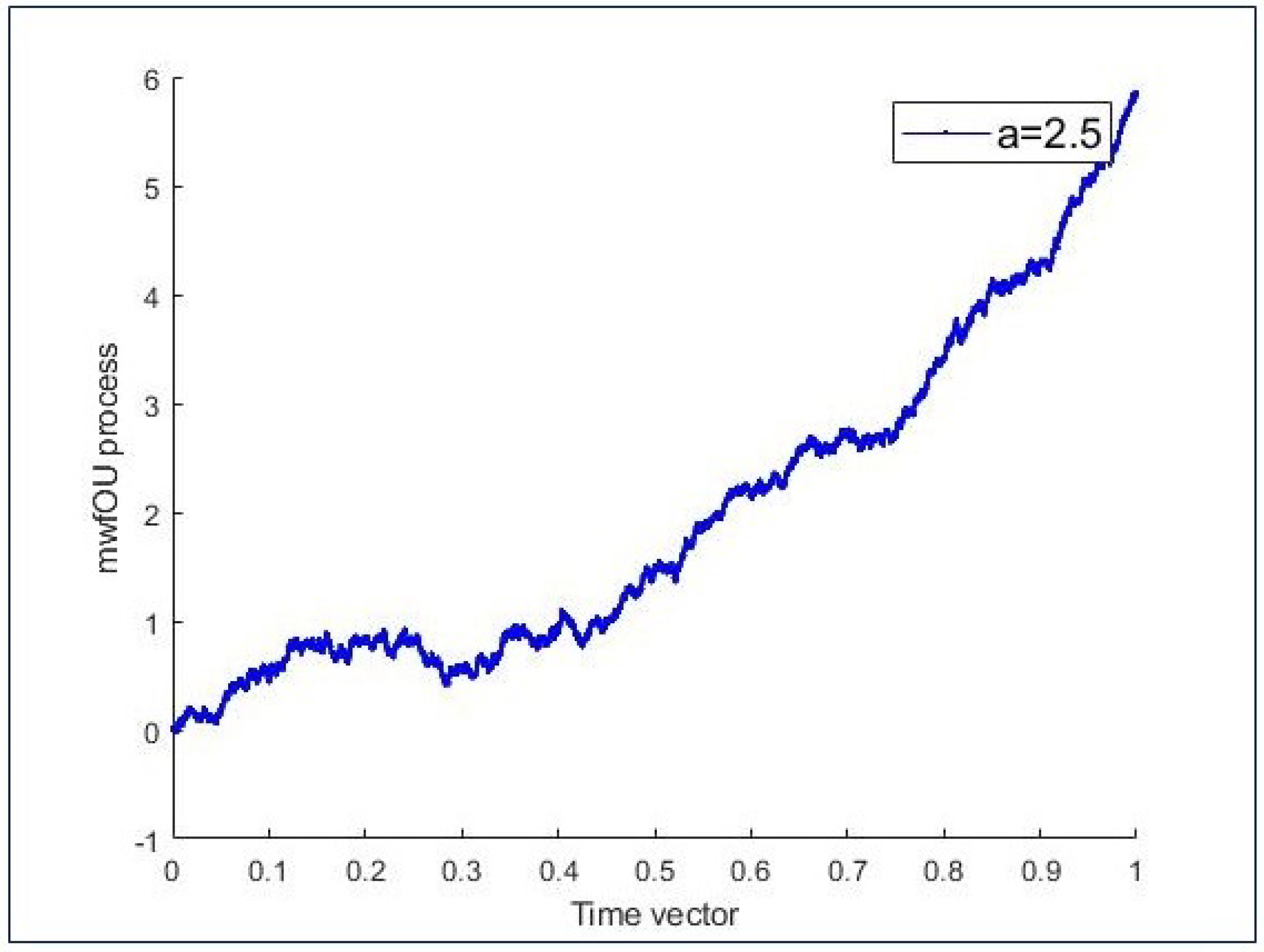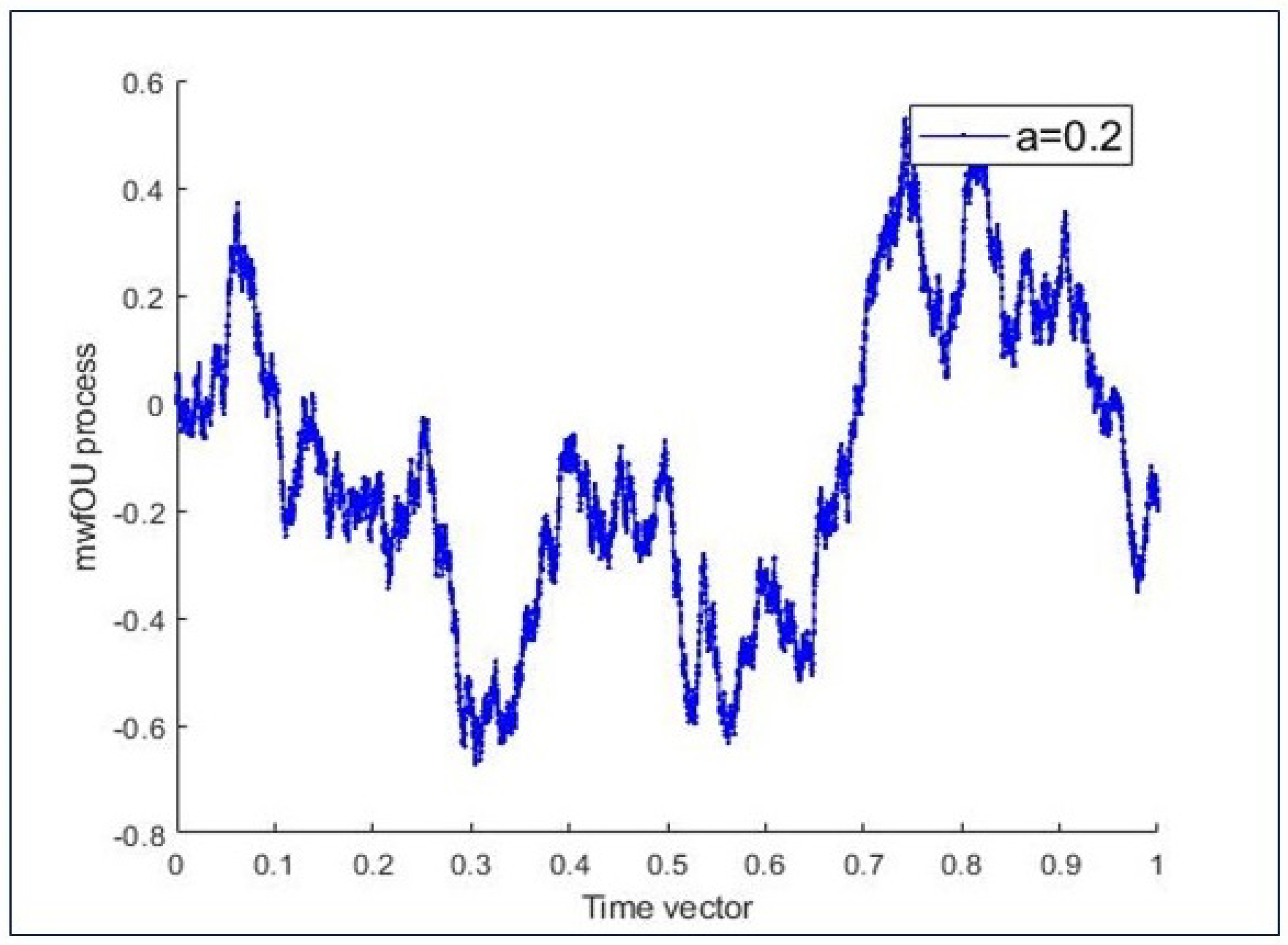A Special Study of the Mixed Weighted Fractional Brownian Motion
Abstract
1. Introduction
2. Notions and Auxiliary Results
A Canonical Innovation Representation for mwfBm
- The symmetric integral of v w.r.t η, is given by
- The forward integral of v in terms of η, is defined by
- The backward integral of v in terms of η, can be expressed as
- , a.s,
- , a.s, if ,
3. Least Square Estimator for the mwfOU Process
The Behavior of LSE
4. Numerical Simulations
- 1.
- Set the sample size and the time span T.
- 2.
- Consider the uniform mesh with step-size and let .
- 3.
- Choose two values for each of the parameters .
- 4.
- Compute the sample paths of by
- 5.
- Approximate the mwfOU process throughwhere and
5. Discussion
6. Conclusions
Author Contributions
Funding
Institutional Review Board Statement
Informed Consent Statement
Data Availability Statement
Acknowledgments
Conflicts of Interest
References
- Bojdecki, T.; Gorostiza, L.G.; Talarczyk, A. A long range dependence stable process and an infinite variance branching system. Ann. Probab. 2007, 35, 500–527. [Google Scholar] [CrossRef][Green Version]
- Bojdecki, T.; Gorostiza, L.G.; Talarczyk, A. Limit theorems for occupation time fluctuations of branching systems I: Long-range dependence. Stoch. Process. Appl. 2006, 116, 1–18. [Google Scholar] [CrossRef]
- Bojdecki, T.; Gorostiza, L.G.; Talarczyk, A. Occupation time limits of inhomogeneous Poisson systems of independent particles. Stoch. Process. Their Appl. 2008, 118, 28–52. [Google Scholar] [CrossRef]
- Dawson, D.A.; Gorostiza, L.G.; Wakolbinger, A. Occupation time fluctuations in branching systems. J. Theoret. Probab. 2001, 14, 729–796. [Google Scholar] [CrossRef]
- Atangana, A. Mathematical model of survival of fractional calculus, critics and their impact: How singular is our world? Adv. Differ. Equ. 2021, 2021, 403. [Google Scholar] [CrossRef]
- Bojdecki, T.; Gorostiza, L.G.; Talarczyk, A. Some extensions of fractional Brownian motion and sub–fractional Brownian motion related to particle system. Electron. Commun. Probab. 2007, 12, 161–172. [Google Scholar] [CrossRef]
- Alsenafi, A.; Al-Foraih, M.; Es-Sebaiy, K. Least squares estimation for non-ergodic weighted fractional Ornstein–Uhlenbeck process of general parameters. arXiv 2020, arXiv:2002.06861. [Google Scholar]
- Cheng, P.; Shen, G.; Chen, Q. Parameter estimation for non–ergodic Ornstein–Uhlenbeck process driven by the weighted fractional Brownian motion. Adv. Differ. Equ. 2017, 366. [Google Scholar]
- Shen, G.; Yin, X.; Yan, L. Least squares estimation for Ornstein-Uhlenbeck processes driven by the weighted fractional Brownian motion. Acta Math Sci. 2016, 36, 394–408. [Google Scholar] [CrossRef]
- Van den Bos, A. Parameter Estimation for Scientists and Engineers; John Wiley & Sons: Hoboken, NJ, USA, 2007. [Google Scholar]
- Es-Sebaiy, K.; Viens, F. Optimal rates for parameter estimation of stationary Gaussian processes. Stoch. Process. Their Appl. 2019, 129, 3018–3054. [Google Scholar] [CrossRef]
- Hu, Y.; Nualart, D.; Zhou, H. Parameter estimation for fractional Ornstein–Uhlenbeck processes of general Hurst parameter. Stat. Inference Stoch. Process. 2019, 22, 111–142. [Google Scholar] [CrossRef]
- El-Machkouri, M.; Es-Sebaiy, K.; Ouknine, Y. Least squares estimator for non–ergodic Ornstein Uhlenbeck processes driven by Gaussian processes. J. Korean Stat. Soc. 2016, 45, 329341. [Google Scholar] [CrossRef]
- Khalaf, A.D.; Zeb, A.; Sabawi, Y.A.; Djilali, S.; Wang, X.J. Optimal rates for the parameter prediction of a Gaussian Vasicek process. Eur. Phys. J. Plus 2021, 136, 1–7. [Google Scholar]
- Guin, L.N.; Pal, S.; Chakravarty, S.; Djilali, S. Pattern dynamics of a reaction-diffusion predator-prey system with both refuge and harvesting. Int. J. Biomath. 2021, 14, 2050084. [Google Scholar] [CrossRef]
- Djilali, S.; Benahmadi, L.; Tridane, A.; Niri, K. Modeling the impact of unreported cases of the COVID-19 in the North African countries. Biology 2020, 9, 373. [Google Scholar] [CrossRef]
- Bentout, S.; Chen, Y.; Djilali, S. Global dynamics of an SEIR model with two age structures and a nonlinear incidence. Acta Appl. Math. 2021, 171, 1–27. [Google Scholar] [CrossRef]
- Kailath, T.; Poor, H.V. Detection of stochastic processes. IEEE Trans. Inform. Theory 1998, 44, 2230–2259. [Google Scholar] [CrossRef]
- Cheridito, P. Mixed fractional Brownian motion. Bernoulli 2001, 7, 913–934. [Google Scholar] [CrossRef]
- Mehrdoust, F.; Najafi, A.R.; Samimi, H. A mixed fractional Vasicek model and pricing Bermuda option on zero-coupon bonds. Sādhanā 2020, 2020, 45–58. [Google Scholar] [CrossRef]
- Khalaf, A.D.; Abouagwa, M.; Mustafa, A.; Wang, X. Stochastic Volterra integral equations with jumps and the strong superconvergence of the Euler–Maruyama approximation. J. Comput. Appl. Math. 2021, 15, 113071. [Google Scholar] [CrossRef]
- Sabawi, Y.A.; Pirdawood, M.A.; Khalaf, A.D. Semi-Implicit and Explicit Runge Kutta Methods for Stiff Ordinary Differential Equations. J. Phys. Conf. Ser. 2021, 1999, 012100. [Google Scholar] [CrossRef]
- Moghaddam, B.P.; Lopes, A.M.; Machado, J.A.T.; Mostaghim, Z.S. Computational scheme for solving nonlinear fractional stochastic differential equations with delay. Stoch. Anal. Appl. 2019, 37, 893–908. [Google Scholar] [CrossRef]
- Tesfay, A.; Tesfay, D.; Khalaf, A.D.; Brannan, J. Mean exit time and escape probability for the stochastic logistic growth model with multiplicative α-stable Lévy noise. Stochastics Dyn. 2021, 21, 2150016. [Google Scholar] [CrossRef]
- Cai, C.; Chigansky, P.; Kleptsyna, M. Mixed Gaussian process: A filtering approach. Ann Probab. 2016, 44, 3032–3075. [Google Scholar] [CrossRef]
- Khalaf, A.D.; Abouagwa, M.; Wang, X.J. Periodic averaging method for impulsive stochastic dynamical systems driven by fractional Brownian motion under non–Lipschitz condition. Adv. Differ. Equ. 2019, 526, 1–15. [Google Scholar] [CrossRef]
- Nualart, D. Malliavin Calculus and Related Topics; Springer: Berlin, Germany, 2006. [Google Scholar]
- Cai, C.; Wang, Q.; Xiao, W. Mixed sub–fractional Brownian motion and drift estimation of related Ornstein–Uhlenbeck process. arXiv 2018, arXiv:1809.02038. [Google Scholar]
- Shepp, L.A. Radon–Nikodym derivatives of Gaussian measures. Ann. Math. Stat. 1966, 1, 321–354. [Google Scholar] [CrossRef]
- Asmussen, S.; Glynn, P.W. Stochastic Simulation: Algorithms and Analysis; Springer Science and Business Media: Berlin/Heidelberg, Germany, 2007. [Google Scholar]


Publisher’s Note: MDPI stays neutral with regard to jurisdictional claims in published maps and institutional affiliations. |
© 2021 by the authors. Licensee MDPI, Basel, Switzerland. This article is an open access article distributed under the terms and conditions of the Creative Commons Attribution (CC BY) license (https://creativecommons.org/licenses/by/4.0/).
Share and Cite
Khalaf, A.D.; Zeb, A.; Saeed, T.; Abouagwa, M.; Djilali, S.; Alshehri, H.M. A Special Study of the Mixed Weighted Fractional Brownian Motion. Fractal Fract. 2021, 5, 192. https://doi.org/10.3390/fractalfract5040192
Khalaf AD, Zeb A, Saeed T, Abouagwa M, Djilali S, Alshehri HM. A Special Study of the Mixed Weighted Fractional Brownian Motion. Fractal and Fractional. 2021; 5(4):192. https://doi.org/10.3390/fractalfract5040192
Chicago/Turabian StyleKhalaf, Anas D., Anwar Zeb, Tareq Saeed, Mahmoud Abouagwa, Salih Djilali, and Hashim M. Alshehri. 2021. "A Special Study of the Mixed Weighted Fractional Brownian Motion" Fractal and Fractional 5, no. 4: 192. https://doi.org/10.3390/fractalfract5040192
APA StyleKhalaf, A. D., Zeb, A., Saeed, T., Abouagwa, M., Djilali, S., & Alshehri, H. M. (2021). A Special Study of the Mixed Weighted Fractional Brownian Motion. Fractal and Fractional, 5(4), 192. https://doi.org/10.3390/fractalfract5040192





